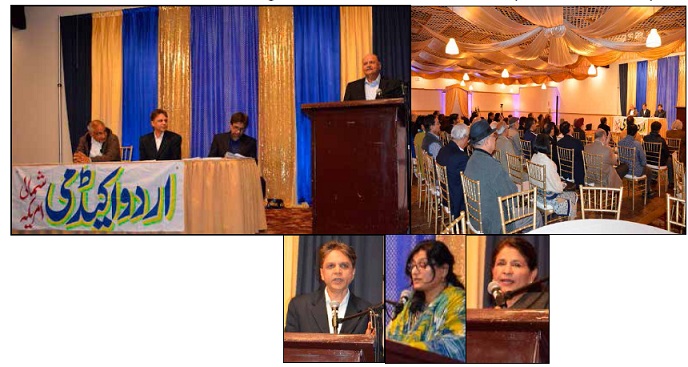Cemendtaur's Latest Travelogue Launched at Urdu Academy in Silicon Valley
By RiazHaq

"UlatDunyaKeeSair", Ali Hasan Cemendtaur's latest travelogue written in Urdu, was launched on January 15, 2017 at an event organized by the Urdu Academy of North America, a Silicon Valley-based group dedicated to the promotion of Urdu language in the United States and Canada.
The travelogue tells the story of the author's travels to the world Down Under (appropriately translated by the author in Urdu as "UlatDunya”, specifically, the three southern hemisphere nations of Australia, New Zealand and Fiji.
The event was chaired by Khwaja Ashraf sahib, a published Urdu writer in his own right, and attended by many local Urdu lovers hailing originally from South Asia. It was emceed by Arshad Rashid sahib who, along with TasheeZaheer sahib, runs theUrdu Academy. Other presenters included Kausar Syed sahiba, Mariam Turabsahiba and RiazHaq. The program concluded with Ali Hasan Cemendtaur's hilarious and self-deprecating roast of his own writing that he called "ApniGheebat". Please follow the embedded links or search Youtube for the individual names to find and watch the presentations.
In his presentation, RiazHaq said "the history is often referred to as "His Story", a description acknowledging the fact that the history writer's worldview influences his or her work. This reality applies to travelogues as well".
We are used to reading world travel accounts written by Western travelers; Ali Hasan Cemendtaur's travelogues, written in English or Urdu, are rare exceptions as they get the reader to see the world through the eyes of a Pakistani traveler.
"The Green Ibn Battuta", the title of Cemendtaur's last travelogue launched last year, is a tribute to Ibn Battuta, the 14th century Muslim traveler from North Africa who wrote extensively about his travels of much of the known world at the time. Ali's Ibn Battuta covers his travels starting in 1990s. The fact that Cemendtaur's access to modern transportation enabled him to see a lot more of the world in a relatively short time than Ibn Battuta did, would make the 14th century traveler green with envy; hence the title "Green Ibn Battuta".
Ali's Pakistani-ness drove his curiosity to visit Multan Karavansarai in Baku, Azerbaijan., where he discovered old trade ties between the Pakistani city of Multan and the Central Asia region dating back to the 15th century.
Cemendtaur's Pakistani origin compelled his interest in The Caucasus (KohQaaf), the mountainous region 1,000 by 600 km in size that lies between the Black Sea and the Caspian Sea, where Azerbaijan is located. KohQaaf (Caucasus mountain) is associated with many fairytales that Pakistani children have grown up with. Dastaan e Amir Hamza is an Urdu collection of fairytales from KohQaf that continues to fascinate Pakistanis to this day. The Caucasian label, the US official race classification for American whites, traces the origin of all white Europeans to the Caucasus region.Harvard genetic studies have confirmed that the ancestors of many Ancestral North Indians and Pakistanis came from this region.
In "UlatDunyaKeeSair", Cemendtaur's interest in South Asian language shows through in his impressions of the language spoken in Fiji by people of South Asian origin who speak a variant of Hindi but switch to "Bollywood Hindi" when conversing with Urdu- or Hindi-speaking visitors.
Cemendtaur writes about dealing with what he thought was "gutter smell" in Rotorua, New Zealand, and expresses his shock that a developed nation like New Zealand could have the kind of stink more common in developing nations of South Asia in areas with open sewers. He soon finds out that it was the smell of hydrogen sulfide emanating from sulfur-laden water from hot springs in the area.
The author also notices that, unlike Australia where most immigrants are Chinese, the immigrants from South Asia are more visible in New Zealand. Apparently, there are many Punjabi farmers in dairy business who have been living there since the days of the British Raj.
Cemendtaur finds a Hazara town in Sydney with many Hazara Shias from Pakistan who have fled sectarian conflict to find safety in Australia. Upon research, he finds that human smugglers provide this service for a substantial fee by flying Hazaras to Sri Lanka, then arranging visas to Indonesia from where they are put on boats to Australia.
RiazHaq concluded his presentation by recommending "UlatDunyaKeeSair" as a well-written Urdu travelogue "filled with entertaining anecdotes and insightful observations about many exotic places and interesting cultures. It is written in an easy to read and highly engaging style that will keep you absorbed and make you finish it in one sitting once you start reading it."
The event concluded with a very self-deprecating and humorous monologue by Ali Hasan Cemendtaur that reminded the audience of Zia Mohyeddin's reading of MushtaqYusufi's work.
Here are a couple of video clips of the event:
https://youtu.be/PQDyq3Q6rKc
https://youtu.be/d7nylUVYad0

